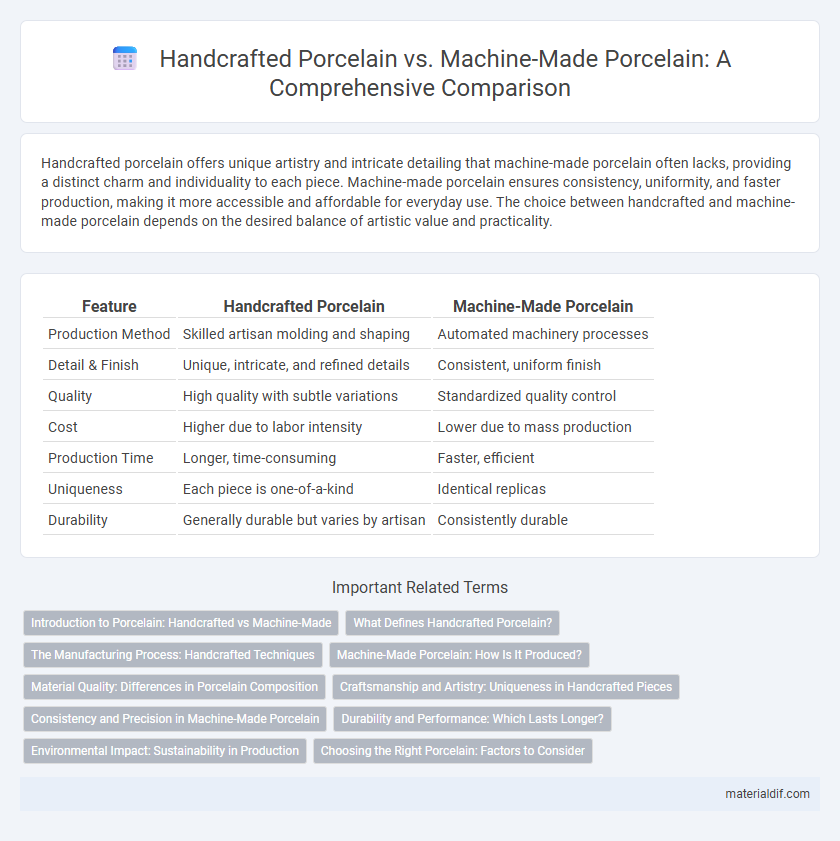Handcrafted porcelain offers unique artistry and intricate detailing that machine-made porcelain often lacks, providing a distinct charm and individuality to each piece. Machine-made porcelain ensures consistency, uniformity, and faster production, making it more accessible and affordable for everyday use. The choice between handcrafted and machine-made porcelain depends on the desired balance of artistic value and practicality.
Table of Comparison
| Feature | Handcrafted Porcelain | Machine-Made Porcelain |
|---|---|---|
| Production Method | Skilled artisan molding and shaping | Automated machinery processes |
| Detail & Finish | Unique, intricate, and refined details | Consistent, uniform finish |
| Quality | High quality with subtle variations | Standardized quality control |
| Cost | Higher due to labor intensity | Lower due to mass production |
| Production Time | Longer, time-consuming | Faster, efficient |
| Uniqueness | Each piece is one-of-a-kind | Identical replicas |
| Durability | Generally durable but varies by artisan | Consistently durable |
Introduction to Porcelain: Handcrafted vs Machine-Made
Handcrafted porcelain offers unique artistry and intricate detailing, reflecting the individual skill of the artisan, whereas machine-made porcelain emphasizes uniformity and mass production efficiency. The difference in production methods affects texture, durability, and aesthetic value, with handcrafted pieces often exhibiting slight variations that enhance their charm. Advances in technology have streamlined machine-made porcelain fabrication, yet handcrafted porcelain remains prized for its exclusivity and traditional craftsmanship.
What Defines Handcrafted Porcelain?
Handcrafted porcelain is defined by its artisanal production process, where skilled artisans meticulously shape, mold, and decorate each piece, resulting in unique variations and intricate detailing. This method emphasizes the use of traditional techniques such as wheel-throwing and hand-painting, which contribute to the porcelain's distinctive texture and character. Unlike machine-made porcelain, handcrafted pieces often showcase subtle imperfections that highlight their authenticity and craftsmanship.
The Manufacturing Process: Handcrafted Techniques
Handcrafted porcelain involves skilled artisans shaping, molding, and painting each piece with precision, often utilizing traditional methods such as wheel throwing and hand sculpting, which ensure unique textures and intricate details. This process includes multiple stages of firing and glazing that are carefully controlled to enhance the porcelain's strength and translucency. Unlike machine-made porcelain, handcrafted techniques emphasize individual craftsmanship, resulting in subtle variations and a distinct aesthetic quality.
Machine-Made Porcelain: How Is It Produced?
Machine-made porcelain is produced through automated processes involving precise molding, pressing, and firing techniques that ensure consistent quality and uniformity. Advanced machinery injects liquid porcelain slip into detailed molds, followed by controlled drying and high-temperature kiln firing to achieve strength and translucency. This method allows for large-scale production with minimal human intervention, yielding cost-effective and standardized porcelain products.
Material Quality: Differences in Porcelain Composition
Handcrafted porcelain typically uses higher-quality kaolin clay and feldspar, resulting in a finer, more translucent finish with fewer impurities compared to machine-made porcelain. Machine-made porcelain often incorporates lower-grade materials and additives to speed production and reduce costs, which can affect durability and smoothness. The distinct differences in raw material composition directly impact the strength, texture, and aesthetics of the final porcelain product.
Craftsmanship and Artistry: Uniqueness in Handcrafted Pieces
Handcrafted porcelain showcases exceptional craftsmanship, where artisans meticulously shape and decorate each piece, resulting in unique variations impossible to replicate by machines. The artistry involved in handcrafted porcelain emphasizes intricate details and personalized touches, enhancing the aesthetic and cultural value of each item. In contrast, machine-made porcelain offers uniformity but lacks the distinctive character and subtle imperfections that define handcrafted masterpieces.
Consistency and Precision in Machine-Made Porcelain
Machine-made porcelain offers unparalleled consistency and precision, ensuring uniform thickness, smooth surfaces, and exact replicability of intricate designs. Advanced automation techniques reduce human error, resulting in flawless, high-quality products ideal for mass production and commercial use. This precision enhances durability and aesthetic appeal, making machine-made porcelain a preferred choice for standardized applications.
Durability and Performance: Which Lasts Longer?
Handcrafted porcelain typically offers superior durability due to the meticulous attention and quality control applied during its production, resulting in fewer defects and enhanced strength. Machine-made porcelain can maintain consistent performance but often sacrifices long-term durability because of uniform firing processes and potential microscopic flaws. Overall, handcrafted porcelain tends to last longer, providing better resistance to chipping and wear over time.
Environmental Impact: Sustainability in Production
Handcrafted porcelain typically involves traditional techniques that consume less energy and produce minimal waste compared to machine-made porcelain, which relies heavily on industrial processes and high electricity usage. Artisans often source local materials sustainably, reducing carbon footprints, while mass production frequently uses non-renewable resources and generates significant emissions. Emphasizing handcrafted porcelain supports eco-friendly practices and promotes sustainable production within the ceramics industry.
Choosing the Right Porcelain: Factors to Consider
Choosing the right porcelain involves evaluating factors such as durability, design precision, and production method. Handcrafted porcelain offers unique artistry and subtle variations, enhancing its aesthetic value, while machine-made porcelain ensures uniformity and cost-efficiency suited for large-scale use. Consider your budget, intended use, and preference for craftsmanship or consistency when selecting between handcrafted and machine-made porcelain.
Handcrafted Porcelain vs Machine-Made Porcelain Infographic

 materialdif.com
materialdif.com